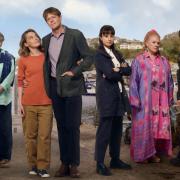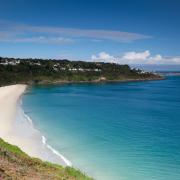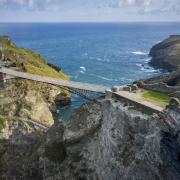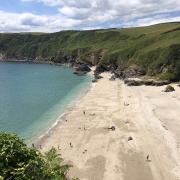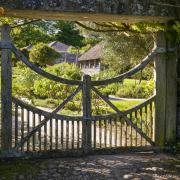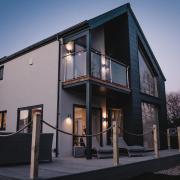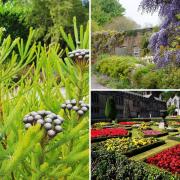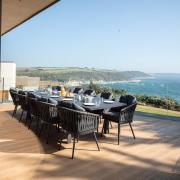The harbour town of Penzance is famous for more than just singing pirates - there are plenty of heroes and villains both real and imagined... finds award-winning photographer David Chapman
The date of the first harbour built in Penzance is unclear. Although we do know that overseas trade was taking place in the Iron Age it is likely that the harbour at St Michael’s Mount stole the lion’s share of this business being an iconic and secure location. Even the town of Penzance was a late developer, it wasn’t mentioned in the Domesday Book, although Alwarton, now Alverton, was.
Because of its geographical position Penzance is remote from the centre of power in England and, as such, it has proved vulnerable to attack from the sea throughout its history. Probably the best-known incursion was in 1595 when the Spanish invaded and ransacked Penzance, Mousehole and Newlyn, setting alight many of the buildings. They were soon repelled but it took many years for Penzance to recover and violent incursions didn’t stop there.

It seems astonishing today but for a period of about three centuries the coastline around Cornwall, and many other parts of the UK and Europe, was at the mercy of Barbary pirates. Their aim was to capture people to satisfy a demand for slaves in North Africa, or to claim a ransom for their return. Our naval deterrent was weak so the pirates could strike almost at will.
In 1625 Mounts Bay was raided and 60 people were taken captive then in 1645 another 240 were taken with Penzance being badly hit. Money was paid as a ransom to release hundreds of captives and several naval bombardments of North Africa were made by a whole range of countries but it wasn’t until 1816 that the Barbary pirates were beaten and more than 4,000 slaves were released.

The connection of pirates to Penzance was given a long-term boost by the opera Pirates of Penzance, written by Gilbert and Sullivan which premiered in New York on 31 December 1879. The story is about a young man who is destined to serve with a bunch of gentlemanly pirates, until his 21st birthday. As soon as he is released from his service he meets and falls in love with the daughter of a Major-General (hence the well-known song). However he then discovers that he was born on the 29th of February and therefore has not technically reached his 21st birthday and he decides the correct thing to do is to return to the pirates. His true love decides she will wait for him even though that means waiting for another 63 years, but it all ends well as he is freed from his service when the band is broken up by police.
The romanticised view of piracy has been adopted by the town in a number of ways. We have the The Cornish Pirates, rugby team; there is a fairly regular attempt to break the world record for the number of pirates in one location at the same time; visit a meadery and you have a good chance of finding a waiter or waitress dressed in pirate gear.

Pirates weren’t the only law-breakers to have a grip on the town. In the late 18th century smuggling was said to be out of control in Penzance. In 1770 even the mayor of Penzance was found to be involved in the smuggling scene and locals had a range of strategies to avoid being caught including tunnels leading from the harbour to both the Admiral Benbow and Turk’s Head pubs on Chapel Street.
Throughout much of its history Penzance harbour plied a significant fishing trade with pilchards being important to the economy, just as they were in most Cornish harbours, but it remained quite a small harbour until in the 17th and 18th centuries when its importance grew with the export of tin. In 1663 Penzance was made a coinage town, where tin could be weighed and taxed, this brought considerable wealth to the town over the next couple of centuries.
There were originally four smelting works in the local area, at Ludgvan, Gulval, Trereife and Madron. Operations at these locations were watched carefully by supervisors appointed by the government but even with strict regulations in place the temptation to smuggle illicit tin was too great for some. The pewter workers of Penzance were thought to be involved in smuggling tin because once the tin was melted down to make pewter it was impossible to tell whether it was legitimately ‘coined’ or not.

During the boom provided by the export of tin there was a big expansion of the harbour. In 1745 the quay was built and then extended in 1782, the first lighthouse was constructed in 1817 with the current one being built in 1853 when the quay was extended still further.
Abbey Warehouse, now a Grade II listed building, was built in the early to mid-19th century. The small dry dock within Abbey Basin, accessed through the Ross Bridge, is tidal and was created in 1814, it still serves as a ship refitting and repair service for vessels up to 75 metres long. The Ross Bridge was first built in 1881 using an old railway turntable, it was later rebuilt in 1981. It was named after Charles Campbell Ross who was mayor of Penzance five times in the late 19th century and was also an MP. His family home is now Morrab House and Gardens.
Albert Pier was built between 1845 and 1847. We complain about modern-day building projects going over-budget but this isn’t a modern phenomenon, the construction of Albert Pier went 50% over budget reaching an equivalent of about £15 million in today’s money.
With the railway connection arriving in Penzance in 1852 there was an immediate impact on the ability to export goods and import tourists, though it wasn’t until 1866 that there was a direct train journey to London. A railway line was laid along Albert Pier to assist with the loading and unloading of ships. Wharf Road was built in the 1880’s to give better access to the harbourside and the inner dock, complete with gates was opened in 1884.

In the 20th century the biggest source of income for Penzance became tourism. One of the most iconic symbols of this around the harbour is the Scillonian which has taken tourists to the Isles of Scilly since the 1920’s. The first ship to travel the route was a converted fishery protection vessel in 1920 but in 1925 a new ship, The Scillonian, was launched.
Tourists from London could book on an overnight sleeper train from Paddington Station and arrive at Penzance just in time to transfer to The Scillonian and spend a day on the Isles of Scilly before returning by the same route. The Scillonian II was launched into service in 1956 and Scillonian III, the current ship, came into service in 1977.
Photography
There are plenty of vantage points for photographing the harbour and a good mix of possible subjects from the older, more characterful vessels in the inner harbour to the shiny yachts in the tidal harbour. Arguably the best light is late in the day when you can stand on Ross Bridge and look out towards St Michael’s Mount with the sun behind you and see everything gleaming. If you time your visit carefully you can get the Scillonian arriving through the harbour entrance with St Michael’s Mount in the background.

Wildlife
Penzance harbour and the surrounding rocks have become the best place in Cornwall to see eider ducks. These ducks were quite rare in Cornwall until the last few years when more have been seen. In winter there is a regular group of purple sandpipers on Battery Rocks, between the harbour and Jubilee Pool, these often associate with turnstones and sometimes sanderling and dunlin.
Wildlife-watching boat trips are a feature of Penzance harbour, there are a couple of operators. These trips offer a range of possible wildlife including dolphins, sunfish and various seabirds and Mounts Bay has become the most regular place to find Risso’s dolphins in Cornwall.
To see more of David’s photography visit his website at davidchapman.org.uk or look out for his book ‘Photographing Cornwall’ available in all local bookshops.







